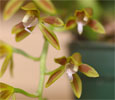|
|
|
|
|
| |
Flasks of
Macradenia lutescens 'MC3686' × self |
|
| |
|
|
| |
| Number: |
TN5512 |
| Name: |
Macradenia lutescens 'MC3686' × self
|
| Type: |
self (What's that?) |
|
Click to Enlarge

Pod Parent Flowers |
|
|
|
| |
Culture Notes from Donor: Parent plant: Temperature range I (60-83°F). These epiphytic orchids like shaded conditions and moist or humid culture.
Comments: Parent plant: Small plant. Once native to southern Florida but is now extinct there. This plant was purchased from Tropical Orchid Farm in Hawaii.
For additional origin/habitat information supplied courtesy of
Charles and Margaret Baker, see further below, near the bottom of this page.
|
Temperatures we attempt to use in the lab & greenhouse:
| For Species: |
|
Spring, Summer, Autumn, Winter: days average 86°F, nights 68°F; best fit is Warm-Intermediate 87-64°F
(Source:
Baker's Web OSC) |
|
About the name...
| Etymology of |
lutescens |
|
From Latin "lutescens" yellowish, becoming yellow.
(Source:
Mayr & Schmucker 1998) |
| Etymology of |
Macradenia |
|
From Latin "makros" large; "aden" gland. Reffering to the long stipites.
(Source:
Mayr & Schmucker 1998) |
| Pronunciation of |
lutescens |
|
loo-TES-enz
(Source:
Hawkes 1978) |
| Pronunciation of |
Macradenia |
|
mak-ra-DEN-ee-ah
(Source:
Hawkes 1978) |
|
If you would like to direct someone to this web page, please copy and paste this URL into your email:
http://troymeyers.com/d?015512
| Flask Information |
| Availability: |
We have sold all of the flasks for this item. |
| You should: |
Consider getting individual plants or compots instead of a flask.
You can place a "Notify Flask Recipients" Request, and either we or a flask recipient may contact you when plants are available.
You may also place a "Notify Retries" Request, and if an identical pollination (the same parents) is done again, we'll let you know.
You may reserve a flask, but it's very unlikely you'll get one ...this could only happen if we found a flask that we didn't know we had. |
| Yield Estimate: |
1038 plants (based on flask surveys done 07/05/2007 through 06/15/2011)
|
| Plantlet Sizes: |
From many flasks 0.2 - 80 mm plants (based on flask surveys done 07/16/2007 through 01/04/2012)
From one most recently surveyed flask 35 - 70 mm (01/04/2012)
|
|
You might also want to:
|
View the seed assay for this item.
View items of the same species.
View items of the same genus.
|
| Ordering Information |
| You are not currently logged in. |
|
You must be a registered user and be logged in to reserve a flask or place a notification request. Please log in:
|
|
|
|
|
|
| |
The origin/habitat information below is supplied courtesy of Charles and Margaret Baker
The following information is based on the name of the plant provided by the donor, and assumes that the name is correct. If the plant has been misidentified, then the following information may not be correct.
This text is copyrighted by the Bakers and may not be reproduced without permission.
ORIGIN/HABITAT: Extreme southern Florida, the Bahamas, and Cuba with
distribution continuing southward through the other islands of the
Caribbean into Surinam, Guyana, Venezuela, Colombia, Ecuador, and Peru in
northern South America. This orchid was first found in Florida in 1903
growing in a densely wooded hammock near Homestead in Dade County. Luer
(1972) reported that although this orchid was originally found in several
similar locations in southern Florida, by 1972 the plants had been
completely removed from all but one site which was just within the
boundaries of the Everglades National Park. In Cuba, plants are known from
near San Juan, the Isle of Pines, the Sierra de Cubitas, and the Camagüey
region. Plants are known from several areas in Jamaica. In Venezuela,
plants have been found in the state of Bolívar along the Río Paragua, but
no other details were reported. In Colombia, plants grow in hot lowland
regions at elevations below 3300 ft. (1000 m). In Ecuador, plants are
found in wet forests at 650-1500 ft. (200-450 m), with collections
reported in the province of Napo and in Sucumbios. In Peru, plants have
been collected in the department of San Martín where they were growing
high on tree trunks in wet forest at 1300 ft. (400 m) and in the
department of Pasco where plants were growing in tropical rain forest near
Oxapampa at 800 ft. (250 m).
More about this information and the Bakers...
|
|
|
| |
|
|
|